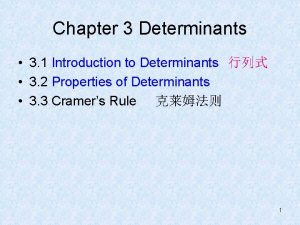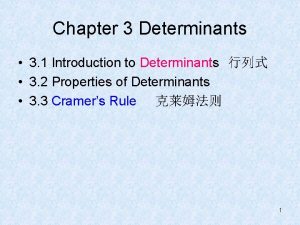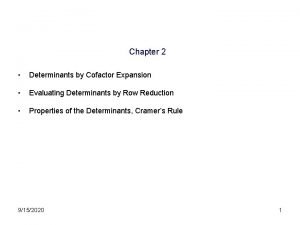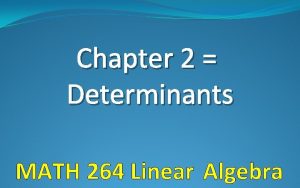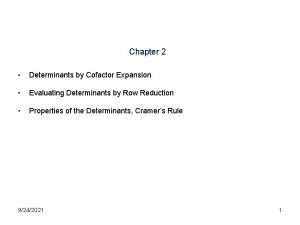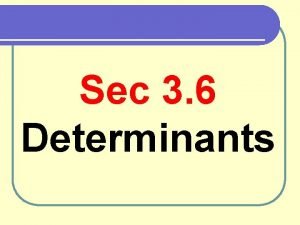Chapter 3 Determinants 3 1 Introduction to Determinants









![代数余子式 • Given A=[aij], the (i, j)-cofactor of A is the number Cij given 代数余子式 • Given A=[aij], the (i, j)-cofactor of A is the number Cij given](https://slidetodoc.com/presentation_image_h/0f53d1cb4783fc53db5a9913cf5bf2cc/image-10.jpg)
![代数余子式 • 对矩阵 A=[aij], 称 为aij对应的代数余子式. This formula is called a cofactor expansion across 代数余子式 • 对矩阵 A=[aij], 称 为aij对应的代数余子式. This formula is called a cofactor expansion across](https://slidetodoc.com/presentation_image_h/0f53d1cb4783fc53db5a9913cf5bf2cc/image-11.jpg)







- Slides: 18

Chapter 3 Determinants • 3. 1 Introduction to Determinants 行列式 • 3. 2 Properties of Determinants • 3. 3 Cramer’s Rule 克莱姆法则 1

• THEOREM 4 Let , if ad – bc 0, then A is invertible and. If ad – bc = 0, then A is not invertible 2

3. 1 Introduction to Determinants • A is invertible, a 11 0. 3

A is invertible, must be nonzero. The converse is true, too. We call the determinant of the A. 4


6

7

• DEFINITION • For n 2, the determinant of an n×n matrix A is the sum of n terms of the form a 1 jdet. A 1 j, with plus and minus signs alternating, where the entries a 11, a 12, …, a 1 n are from the first row of A. In symbols, 8

![代数余子式 Given Aaij the i jcofactor of A is the number Cij given 代数余子式 • Given A=[aij], the (i, j)-cofactor of A is the number Cij given](https://slidetodoc.com/presentation_image_h/0f53d1cb4783fc53db5a9913cf5bf2cc/image-10.jpg)
代数余子式 • Given A=[aij], the (i, j)-cofactor of A is the number Cij given by Then. This formula is called a cofactor expansion across the first row of A. 按第一行展开 10
![代数余子式 对矩阵 Aaij 称 为aij对应的代数余子式 This formula is called a cofactor expansion across 代数余子式 • 对矩阵 A=[aij], 称 为aij对应的代数余子式. This formula is called a cofactor expansion across](https://slidetodoc.com/presentation_image_h/0f53d1cb4783fc53db5a9913cf5bf2cc/image-11.jpg)
代数余子式 • 对矩阵 A=[aij], 称 为aij对应的代数余子式. This formula is called a cofactor expansion across the first row of A. 按第一行展开 11

• THEOREM 1 • The determinant of an n×n matrix A can be computed by a cofactor expansion across any row or down any column. The expansion across the ith row using the cofactors is 12

• The cofactor expansion down the jth column is 13

• THEOREM 2 • If A is a triangular matrix, then det. A is the product of the entries on the main diagonal of A. 14

3. 2 Properties of Determinants • THEOREM 3 Row Operations Let A be a square matrix. – a. If a multiple of one row of A is added to another row to produce a matrix B, then det B = det A. – b. If two rows of A are interchanged to produce B, then det B = - det A. – c. If one row of A is multiplied by k to produce B, then det B = k ·det A. 15

• THEOREM 4 • A square matrix A is invertible if and only if det A 0. • Hint: 16

• THEOREM 5 • If A is an n×n matrix, then det AT = det A. 17

• THEOREM 6 • If A and B are n×n matrices, then det(AB) = (det A)(det B). • Proof: 1) if A is not invertible, then so is not AB, … 2) if A is invertible, then A=Ep…E 1, det(AB) = det (Ep…E 1)B =det Ep(Ep-1 …E 1)B = det Ep • det(Ep-1 …E 1) B =… =det Ep • det. Ep-1 • … • det. E 1 • det. B = det (Ep…E 1) • det. B = det. A • det. B • Homework: 3. 2 Exercises 8, 19, 20, 31, 40 18
 Peek model for readiness to learn
Peek model for readiness to learn Chapter 16 determinants of the money supply
Chapter 16 determinants of the money supply Chapter 16 determinants of the money supply
Chapter 16 determinants of the money supply Chapter 16 determinants of the money supply
Chapter 16 determinants of the money supply The formula for the simple deposit multiplier is
The formula for the simple deposit multiplier is What are the determinants of market structure
What are the determinants of market structure Acdc copyright
Acdc copyright Non price determinants of supply
Non price determinants of supply Non price determinants of supply
Non price determinants of supply Non price determinants of supply
Non price determinants of supply 5 determinants of supply
5 determinants of supply What are the determinants of market structure
What are the determinants of market structure What are the 6 main social determinants of health?
What are the 6 main social determinants of health? Social determinants of personality
Social determinants of personality Les déterminants synthèse
Les déterminants synthèse Pes curves
Pes curves Stimulus in sob model
Stimulus in sob model 2 by 2 matrix inverse example
2 by 2 matrix inverse example Staffing approaches of ihrm
Staffing approaches of ihrm




















